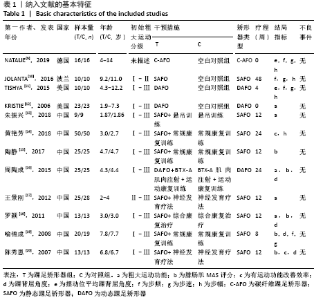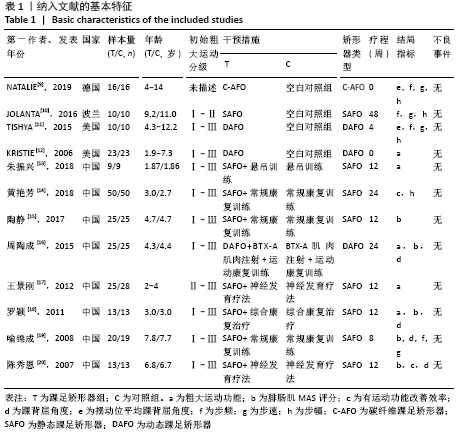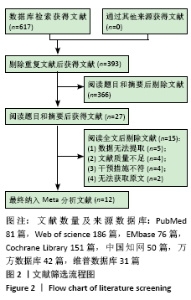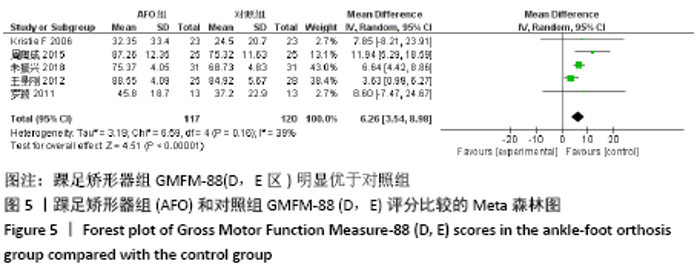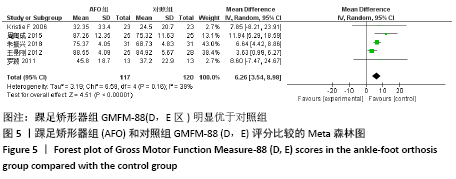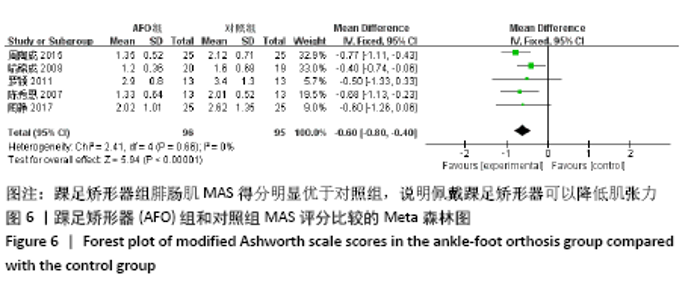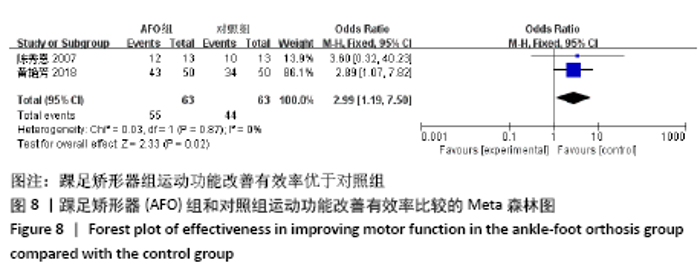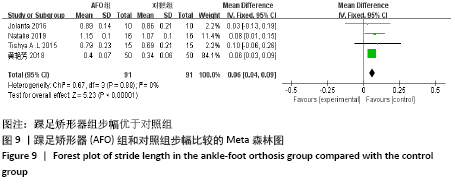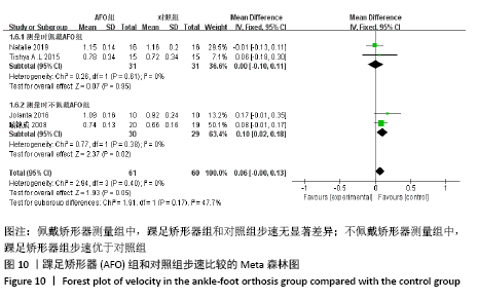Chinese Journal of Tissue Engineering Research ›› 2022, Vol. 26 ›› Issue (8): 1299-1304.doi: 10.12307/2022.239
Ankle-foot orthoses improve motor function of children with cerebral palsy: a Meta-analysis based on 12 randomized controlled trials
Liu Gang, Ma Chao, Wang Le, Zeng Jie, Jiao Yong, Zhao Yi, Ren Jingpei, Hu Chuanyu, Xu Lin, Mu Xiaohong
- Dongzhimen Hospital, Beijing University of Chinese Medicine, Beijing 100700, China
-
Received:2020-11-19Revised:2020-11-21Accepted:2020-12-31Online:2022-03-18Published:2021-11-02 -
Contact:Mu Xiaohong, MD, Professor, Chief physician, Doctoral supervisor, Dongzhimen Hospital, Beijing University of Chinese Medicine, Beijing 100700, China -
About author:Liu Gang, Master candidate, Dongzhimen Hospital, Beijing University of Chinese Medicine, Beijing 100700, China
CLC Number:
Cite this article
Liu Gang, Ma Chao, Wang Le, Zeng Jie, Jiao Yong, Zhao Yi, Ren Jingpei, Hu Chuanyu, Xu Lin, Mu Xiaohong. Ankle-foot orthoses improve motor function of children with cerebral palsy: a Meta-analysis based on 12 randomized controlled trials[J]. Chinese Journal of Tissue Engineering Research, 2022, 26(8): 1299-1304.
share this article
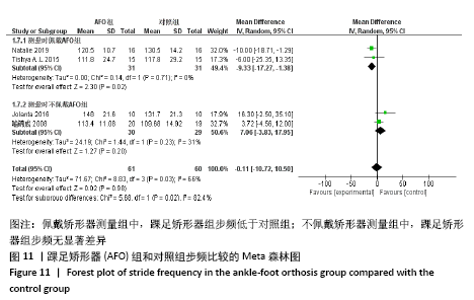
2.3.7 各组步频差异 有4项研究报道了步频变化[13-15,23]。Meta分析中各研究间有异质性(I2=66%),使用随机效应模型。合并结果显示,踝足矫形器组和对照组差异无显著性意义(MD=-0.11,95%CI:-10.72-10.50,P=0.98)。 根据测量步频时有无佩戴踝足矫形器进行亚组分析,两组异质性均显著降低。测量时佩戴踝足矫形器组内各研究间无显著统计学异质性(I2=0%),对照组步频高于踝足矫形器组(MD=-9.33,95%CI:-17.27至-1.38,P=0.02)。测量时不佩戴踝足矫形器组内各研究间有异质性(I2=31%),踝足矫形器组和对照组差异无显著性意义(MD=7.06,95%CI: -3.83-17.95,P=0.20),见图11。"

| [1] 李晓捷,唐久来,马丙祥,等.脑性瘫痪的定义,诊断标准及临床分型[J].中华实用儿科临床杂志,2014,29(19):1520. [2] GULATI S, SONDHI V. Cerebral palsy: an overview. Indian J Pediatr. 2018;85(11): 1006-1016. [3] MU XH, DENG BW, ZENG J, et al. Orthopedic treatment of the lower limbs in spastic paralysis. Brain Sci Adv. 2020;6(1):2-19. [4] SUN Q, HUANG WL, MU XH, et al. The progress in the treatment of spastic cerebral palsy with selective dorsal rhizotomy (SDR). Brain Sci Adv. 2020;6(1):42-55. [5] 穆晓红,李筱叶.痉挛型脑性瘫痪外科治疗专家共识[J].中国矫形外科杂志,2020, 28(1):77-81. [6] RIES AJ, SCHWARTZ MH. Ground reaction and solid ankle-foot orthoses are equivalent for the correction of crouch gait in children with cerebral palsy. Dev Med Child Neurol. 2019;61(2):219-225. [7] LIU XC, EMBREY D, TASSONE C, et al. Long-term effects of orthoses use on the changes of foot and ankle joint motions of children with spastic cerebral palsy. PM R. 2018;10(3):269-275. [8] SACAZE E, GARLANTEZEC R, REMY-NERIS O, et al. A survey of medical and paramedical involvement in children with cerebral palsy in Britanny: preliminary results. Ann Phys Rehabil Med. 2013;56(4):253-267. [9] 唐久来,秦炯,邹丽萍,等.中国脑性瘫痪康复指南(2015):第一部分[J].中国康复医学杂志,2015,30(7):747-754. [10] ABOUTORABI A, ARAZPOUR M, AHMADI BANI M, et al. Efficacy of ankle foot orthoses types on walking in children with cerebral palsy: a systematic review. Ann Phys Rehabil Med. 2017;60(6):393-402. [11] LINTANF M, BOURSEUL JS, HOUX L, et al. Effect of ankle-foot orthoses on gait, balance and gross motor function in children with cerebral palsy: a systematic review and meta-analysis. Clin Rehabil. 2018;32(9):1175-1188. [12] BETANCOURT JP, ELEEH P, STARK S, et al. Impact of ankle-foot orthosis on gait efficiency in ambulatory children with cerebral palsy: a systematic review and meta-analysis. Am J Phys Med Rehabil. 2019;98(9):759-770. [13] ALTSCHUCK N, BAUER C, NEHRING I, et al. Efficacy of prefabricated carbon-composite ankle foot orthoses for children with unilateral spastic cerebral palsy exhibiting a drop foot pattern. J Pediatr Rehabil Med. 2019;12(2):171-180. [14] PAUK J, IHNATOUSKI M, DAUNORAVICIENE K, et al. Research of the spatial-temporal gait parameters and pressure characteristic in spastic diplegia children. Acta Bioeng Biomech. 2016;18(2):121-129. [15] WREN TA, DRYDEN JW, MUESKE NM, et al. Comparison of 2 orthotic approaches in children with cerebral palsy. Pediatr Phys Ther. 2015;27(3):218-226. [16] BJORNSON KF, SCHMALE GA, Adamczyk-Foster A, et al. The effect of dynamic ankle foot orthoses on function in children with cerebral palsy. J Pediatr Orthop. 2006; 26(6):773-776. [17] 朱振兴.悬吊训练配合踝足矫形器对小儿脑瘫膝过伸的疗效研究[J].基层医学论坛,2018,22(31):4410-4411. [18] 黄艳芳,何东梅.踝足矫形器在小儿脑瘫康复中的应用价值分析[J].中国医药科学,2018,8(16):73-75. [19] 陶静.踝足矫形器治疗痉挛型脑瘫患儿动静态尖足的疗效[J].中国伤残医学, 2017,25(3):94-96. [20] 周陶成,童光磊,张敏,等.踝足矫形器联合肉毒毒素治疗痉挛型脑性瘫痪儿童尖足畸形的疗效观察[J].中华物理医学与康复杂志,2015,37(10):761-764. [21] 王景刚,王爱虹,王伟烈,等.定量评定踝足矫形器对痉挛型脑性瘫痪的疗效[J].中国现代医生,2012,50(25):45-46. [22] 罗颖,刘夕东,梅洪.踝足矫形器(AFO)对痉挛型脑瘫运动功能及ADL的作用[J].中国康复,2011,18(6):469-470. [23] 喻锦成.踝足矫形器对痉挛型脑性瘫痪儿童足底压力、足底形态及步态的影响[D].广州:中山大学,2008. [24] 陈秀恩,左群.踝足矫形器在痉挛型脑瘫患儿术后康复治疗中的作用[J].中国康复医学杂志,2007,22(2):174-175. [25] SCHIARITI V, SELB M, CIEZA A, et al. International classification of functioning, disability and health core sets for children and youth with cerebral palsy: a consensus meeting. Dev Med Child Neurol. 2015;57(2): 149-158. [26] 邓博文,徐林,穆晓红,等.腰骶段SPR术对痉挛型脑瘫患儿腰椎稳定性影响的长期观察[J].中国矫形外科杂志,2019, 27(21):1959-1964. [27] MEYNS P, KERKUM YL, BREHM MA, et al. Ankle foot orthoses in cerebral palsy: effects of ankle stiffness on trunk kinematics, gait stability and energy cost of walking. Eur J Paediatr Neurol. 2020;26:68-74. [28] SON I, LEE D, HONG S, et al. Comparison of gait ability of a child with cerebral palsy according to the difference of dorsiflexion angle of hinged ankle-foot orthosis:a case report. Am J Case Rep. 2019;3(20): 1454-1459. [29] SWINNEN E, BAEYENS JP, VAN MULDERS B, et al. The influence of the use of ankle-foot orthoses on thorax, spine, and pelvis kinematics during walking in children with cerebral palsy. Prosthet Orthot Int. 2018; 42(2):208-213. [30] CONTINI BG, BERGAMINI E, ALVINI M, et al. A wearable gait analysis protocol to support the choice of the appropriate ankle-foot orthosis: a comparative assessment in children with Cerebral Palsy. Clin Biomech. 2019;70:177-185. |
| [1] | Jing Jinpeng, Zhang Yue, Liu Xiaomin, Liu Yi. Traditional Chinese medicine injection for promoting blood circulation in prevention of deep vein thrombosis after orthopedic surgery: network meta-analysis [J]. Chinese Journal of Tissue Engineering Research, 2022, 26(9): 1467-1476. |
| [2] | Shan Sharui, Huang Xuming, Zhang Mingxing, Wang Xiukun, Zheng Xiang, Bao Sairong, Hong Feng. Three-dimensional gait analysis of low-frequency repetitive transcranial magnetic stimulation for post-stroke hemiplegia [J]. Chinese Journal of Tissue Engineering Research, 2022, 26(5): 762-767. |
| [3] | Liu Yiyi, Qiu Junqiang, Yi Longyan, Zhou Cailiang. Effect of resistance training on interleukin-6 and C-reactive protein in middle-age and elderly people: a Meta-analysis [J]. Chinese Journal of Tissue Engineering Research, 2022, 26(5): 804-812. |
| [4] | Wang Nan, Qian Yuzhang, Xie Lin. Network Meta-analysis of different acupuncture methods for the treatment of lumbar disc herniation [J]. Chinese Journal of Tissue Engineering Research, 2022, 26(5): 813-820. |
| [5] | Wei Zhoudan, Li Wenjin, Zhu Li, Wang Yu, Zhao Jiaoyang, Chen Yanan, Guo Dong, Hao Min. Platelet-rich fibrin as a material for alveolar ridge preservation significantly reduces the resorption of alveolar bone height and width after tooth extraction: a meta-analysis [J]. Chinese Journal of Tissue Engineering Research, 2022, 26(4): 643-648. |
| [6] | Ou Liang, Kong Dezhong, Xu Daoqing, Ni Jing, Fu Xingqian, Huang Weichen. Comparative clinical efficacy of polymethyl methacrylate and self-solidifying calcium phosphate cement in vertebroplasty: a meta-analysis [J]. Chinese Journal of Tissue Engineering Research, 2022, 26(4): 649-656. |
| [7] | Yang Ruijia, Jiang Lingkai, Dong Zhengquan, Wang Yunfei, Ma Zhou, Cong Linlin, Guo Yanjing, Gao Yangyang, Li Pengcui. Open reduction and internal fixation versus circular external fixation for tibial plateau fractures: a meta-analysis [J]. Chinese Journal of Tissue Engineering Research, 2022, 26(3): 480-486. |
| [8] | Zhong Yuanming, He Bingkun, Wu Zhuotan, Wu Sixian, Wan Tong, Zhong Xifeng. Meta-analysis of efficacy and safety of Jack kyphoplasty for osteoporotic vertebral compression fractures [J]. Chinese Journal of Tissue Engineering Research, 2022, 26(3): 487-492. |
| [9] | Wang Chong, Zhang Meiying, Zhou Jian, Lao Kecheng. Early gait changes after total hip arthroplasty through direct anterior approach and posterolateral approach [J]. Chinese Journal of Tissue Engineering Research, 2022, 26(3): 359-364. |
| [10] | Pan Hao, Zhao Huihui, Wang Jiangjing, Wang Feng, Wang Peng, Shi Qiuling, Guo Jin, Li Lin, Liu Guoqiang. Comparison of kinematic alignment and mechanical alignment to guide gait after total knee arthroplasty [J]. Chinese Journal of Tissue Engineering Research, 2022, 26(3): 365-370. |
| [11] | Zhao Shuying, Guo Guangling, Liu Chenchen, Zhang Chao, Dong Sirui, Gong Qinqin, Ji Luwei. Stem cell transplantation in the treatment of premature ovarian failure: a meta-analysis based on 13 animal studies [J]. Chinese Journal of Tissue Engineering Research, 2022, 26(25): 4084-4092. |
| [12] | Shi Yao, Han Shufeng, Yuan Yitong, Du Ruochen, Jing Zhijie, Zhao Bichun, Zhang Ruxin, Zhang Yujuan, Wang Chunfang. Efficacy and safety of human umbilical cord mesenchymal stem cells in the treatment of spinal cord injury: a meta-analysis [J]. Chinese Journal of Tissue Engineering Research, 2022, 26(25): 4093-4100. |
| [13] | Hao Zhixin, Wu Yixin, Wang Xin, Xia Zhongliang. Effect of anodal transcranial direct current stimulation on muscle strength and endurance: a Meta-analysis [J]. Chinese Journal of Tissue Engineering Research, 2022, 26(20): 3273-3280. |
| [14] | Diao Yulei, Zong Xiaorui, Deng Zhibo, Shu Han. Analgesic effect of adductor canal block versus femoral nerve block after autogenous bone-tendon-bone reconstruction of the anterior cruciate ligament: an updated Meta-analysis [J]. Chinese Journal of Tissue Engineering Research, 2022, 26(2): 315-320. |
| [15] | Zhou Junli, Wang Xiaojun, Wang Haijiao, Li Chun. A network meta-analysis of the efficacy of new medical dressings for diabetic foot ulcers [J]. Chinese Journal of Tissue Engineering Research, 2022, 26(16): 2562-2569. |
| Viewed | ||||||||||||||||||||||||||||||||||||||||||||||||||
|
Full text 172
|
|
|||||||||||||||||||||||||||||||||||||||||||||||||
|
Abstract 750
|
|
|||||||||||||||||||||||||||||||||||||||||||||||||
